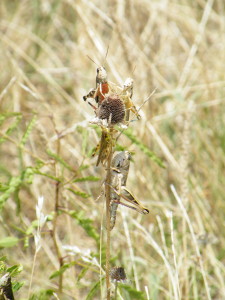Grasshoppers deposit their eggs 1/2 to 2 inches below the soil surface in pod-like structures. Each egg pod consists of 20 to 120 eggs. Egg pods are very resistant to cold and can easily survive the winter if the soil is not disturbed. Grasshoppers deposit eggs in fallow fields, ditches, fencerows, and weedy areas, as well as in crop fields and hay fields.
Eggs begin hatching in late April or early May; hatching peaks about mid-June. If spring weather is cool and dry, hatching may be delayed until July. Young grasshoppers are called nymphs. They look like adults, but are smaller and do not have wings. Nymphs go through 5 to 6 developmental stages and become adults in 40 to 60 days, depending on weather and food supplies.
The adult grasshoppers deposit eggs from late July through the fall. Usually only one generation of grasshoppers is produced each year.
Producers should start watching for grasshoppers early in the season and begin control measures while grasshoppers are still nymphs. Smaller grasshoppers are more susceptible to insecticides than larger ones.
CONTROL OPTIONS:
Cultural Control: Controlling summer weeds reduces available feed for newly hatching nymphs as well as making it easier for birds to prey on grasshoppers.
Chemical Control: Grasshoppers are susceptible to many insecticides. The length of control will depend on the residual activity of the insecticides and the frequency of treatment. Controlling grasshoppers over a large area will reduce the numbers present which can re-infest a treated area. Remember, smaller grasshoppers are more susceptible to insecticides than larger ones.
Insecticides that can be used on pastures and hayfields:
ALWAYS READ AND FOLLOW ALL LABEL INSTRUCTIONS ON PESTICIDES!
Mustang Max (9.6% zeta-cypermethrin)
Karate Z (lambda cyhalothrin): Do not harvest for hay until 7 days after application
Baythroid XL
Dimilin 2L: Dimilin must be applied when grasshoppers are about 1/4 inch. Dimilin is not effective on adults.
Sevin 4F, Sevin XLR, Sevin 80S, generic Carbaryl: 14 day waiting period before grazing or harvesting
Tombstone Helios (cyfluthrin)
Prevathon (RynaXypyr): For optimum control, apply to nymphs.
